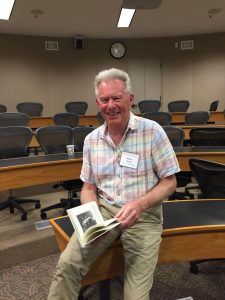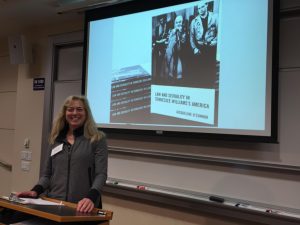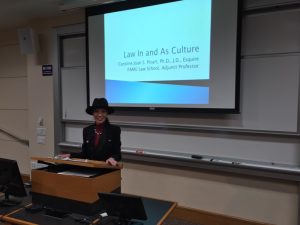The Fairleigh Dickinson University Press Series on Law, Culture and the Humanities presented a panel of papers, based on published and forthcoming books in the series. The panel, titled “FDU Press Book Series on Law, Culture & Humanities: Searching for/Symbolizing Justice and Law in Artistic, Literary, Architectural and Constitutional Narratives,” was presented at the Association for the Study of Law, Culture and the Humanities 2017 Conference at Stanford University Law School on March 31, 2017.
Caroline Joan (Kay) S. Picart’s paper, “Law In and As Culture: American and Australian Aboriginal Case Studies in Copyright Law,” compared and contrasted case studies of copyright protection, as covered by the U.S. Constitution Copyright Clause (Article I, Section 8), and the Australian Copyright Act of 1968. In particular, the paper focused on analyses of cases concerning American women of color (Katherine Dunham and Josephine Baker), in relation to choreography, and Australian Aboriginal artists (as based on the relatively well known Milpurrurru and Others case), in relation to their visual works of art as “traditional communal expressions.” Ultimately, the paper argued that although there are similarities in the critical lacunae these groups occupied in relation to the issues of “authenticity” and “originality” as characterized by copyright law, there were also crucial differences, in terms of the generation of “stardom” and the explicit use of an appeal to communitarian ownership of traditional cultural expressions as a basis for copyright protection.
Jacqueline O’Connor presented a paper, “Law and Sexuality in Tennessee Williams’s America.” The paper showed that two decades in the middle of the twentieth century, American playwright Tennessee Williams reshaped his 1940 play Battle of Angels. The paper argued that manuscripts, letters, and journal entries from the period demonstrate his preoccupation with revising his representations of sexuality and law, and the changes he made provide evidence of his contributions to legal and cultural dialogues on identity formation, intimacy, disgust, and difference.
Peter Robson presented a paper titled, “Architecture, Courts and the Law Reform Process.” This paper focused on recent developments in the law courts in Scotland. The paper showed that major changes are in process of being introduced for Scotland by way of modern justice centers and flexible alternative locations. The paper suggested that the resulting loss of many attractive architectural settings could be regarded as a price worth paying for an improvement in the legal process. Ultimately, the paper argued that a more efficient, humane, transparent and democratic system of justice is the goal, even if it comes at the end of computer screen link up in a “pop up” justice center.
Lowell Brown’s paper, “The Past as Prologue: The American Tradition of Constitutionalism in the Founding Era,” was accepted as part of the panel, but due to unexpected circumstances, Mr. Brown was unable to attend the conference. Brown’s paper argued that the federal Constitution that emerged from the Philadelphia convention in the summer of 1787 was a radical departure from the accepted constitutionalism of the time, exemplified by the British constitution. The paper showed that the convention put forward a democratic reconnection of a constitution that was a unitary and authoritative document that was superior to a legislative act, enumerating limited powers of government and securing fundamental rights that was accessible to everyone that would be ratified by the states rather than being imposed by the imperium. In closing, the paper argued that the new constitutional conception was not simply the invention of the delegates but was the culmination of a uniquely American constitutional tradition originating in the royal charters and covenants upon which the colonial governments had been established.
(Peter Robson) (Jacqueline O’Connor) (Caroline Joan “Kay” S. Picart)
 Fairleigh Dickinson University Press
Fairleigh Dickinson University Press


